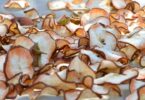If anyone tells you that you can dehydrate watermelons, would you believe it?
Probably not. But, yes squeezing the juice out of watermelon is possible.
Watermelon is 92% water so if you squeeze out all the juice, it would probably turn into mush.
Actually, that is false. You can dehydrate watermelons without turning it into a blob of mush.
READ ALSO: Health Benefits of Eating Dehydrated Watermelon
How to Dehydrate Watermelons
Here are some guidelines as to how you can dehydrate watermelons.
Dehydrating watermelons in a food dehydrator
This method is fast and cost-efficient. The investment in a food dehydrator is a little bit high, but if you regularly dehydrate food, this is a good investment.
- Slice the watermelon into about ¼” slices. Slice it just about the right thinness.
- Get a dehydrator tray, and place all the thin slices of watermelon.
- Set your dehydrator at 135 to 140 degrees, and dry for at least 8 to 12 hours. The time varies, depending on how thick you sliced the watermelon. The thicker your slices, the longer it will take to dehydrate.
- Flip over the watermelon slices every few hours to get even dehydration.
Once dry, let the watermelon slices cool in a rack before storing.
Dehydrating watermelons in oven
If you do not have a dehydrator, you can still dehydrate your watermelon using an oven. Here is a procedure on making dehydrated watermelon jerky.
- Slice your watermelon into ¼” thick strips resembling bacon slices or jerky slices.
- Lay the strips flat on a cooling rack with a cookie sheet. Using a cooling rack will keep the water from pooling.
- Set your oven to 135 degrees Fahrenheit.
- Leave your oven door 2 to 3 inches open and place a fan near the oven door to blow air inside the oven.
- Check your oven every half hour or so and turn the fruit over to get an even dryness.
- Dehydration could take about 18 to 24 hours, depending on the thickness of your watermelon slices.
Allow cooling before storing.
Dehydrating watermelons in a microwave
This is a variation of the conventional oven and the process is the same. Using a microwave is faster than using a conventional oven, but it is still not as economical as using a dehydrator.
- Wash and dry the rotating plate of the microwave. This is where you will place your fruit to dehydrate.
- Cut the watermelon into thin slices about ¼” thick. Do not cut too thin or you will have a difficult time prying them off the plate. A thicker cut, on the other hand, will make them like gummies.
- Place the watermelon slices on the microwave plate, keeping them one inch apart for breathing room.
- Set your microwave to DEFROST setting. This is important if you do not want your watermelon burnt into a crisp.
- Set your timer for 30 minutes.
- Check your fruit frequently and flip the watermelon slices. If you feel they still need further dehydration, you can add a few more minutes.
- Since watermelon is 92% water, it might take at least an hour to get the desired dehydration.
Allow the dried watermelon strips to cool on a cooling rack before storing.
Sun drying watermelons
This is the oldest method of dehydrating watermelons.
It is not advisable to do sun drying during humid and cloudy weather.
The ideal temperature should be 85 degrees Fahrenheit and humidity of 60%.
- Line the rack with parchment paper.
- Cut the watermelon into ¼” thick strips.
- Place the watermelon on the rack with parchment paper, leaving one-inch space as breathing room.
- Cover the rack with fine net or cheesecloth to keep insects away.
- It is ideal to place the racks on blocks and not directly on the ground.
- If you can, place a small fan near the rack for air circulation.
- Sun dry for about 2 to 4 days to extract the moisture completely.
Once completely dehydrated, you need to pasteurize the watermelon to remove insects and eggs that may have settled on the fruit during dehydration.
There are two types of pasteurization, heat or cold. You can do heat pasteurization by heating the watermelon in a shallow pan at 160 degrees Fahrenheit for 30 minutes. You can do cold pasteurization by placing the watermelon in the freezer at 0 degrees Fahrenheit for 2 days.
Storing Dried Watermelons
Dehydrated food is prone to bacteria, insect contamination, and moisture reabsorption.
To prevent problems, follow these steps:
- Completely cool dried watermelon after dehydration. Heat produces moisture and storing them immediately after dehydration could produce moisture, resulting in mold growth.
- Once cooled, pack the watermelon in a dry, moisture proof and insect proof containers like plastic containers, plastic freezer bag or tight-fitting lid jars.
- You can also store in vacuum containers.
- Pack your watermelon in single serving portions. Preserved foods, once open, are prone to mildew and bacteria.
- Keep your container in dark, dry, and cool areas.
Condition your dried watermelon to reduce the growth of bacteria.
Dehydrating watermelon can reduce the space you need to store the fruits once they become ripe.
READ ALSO: How to Store Dried Fruits at Home





